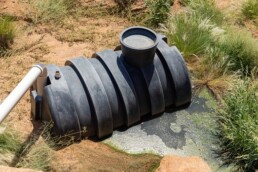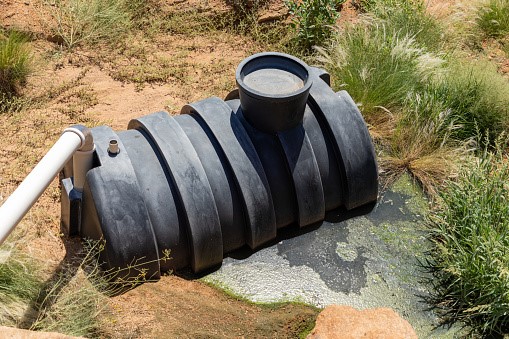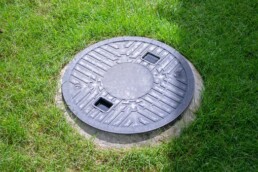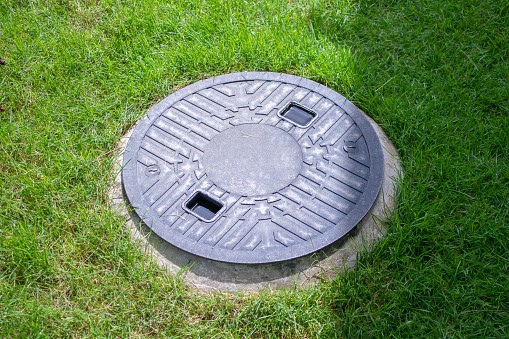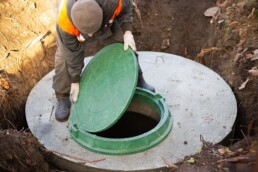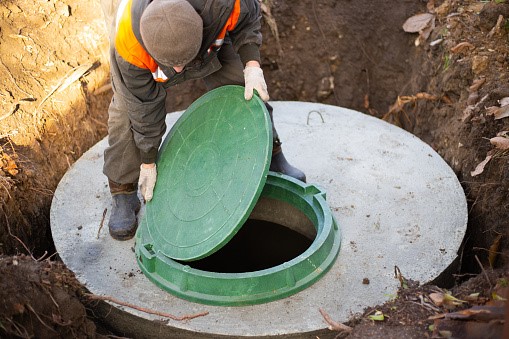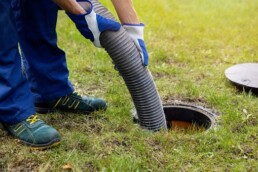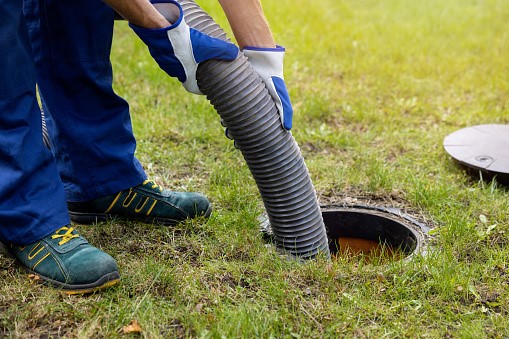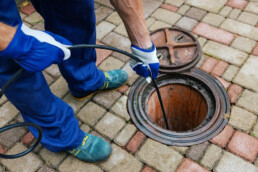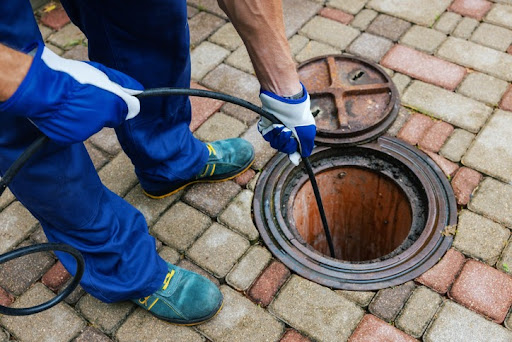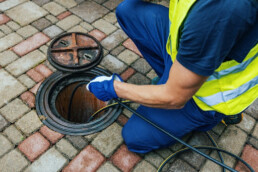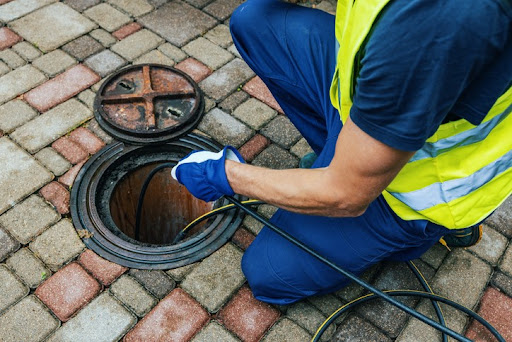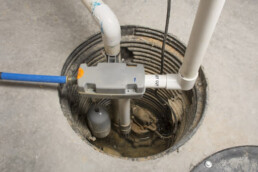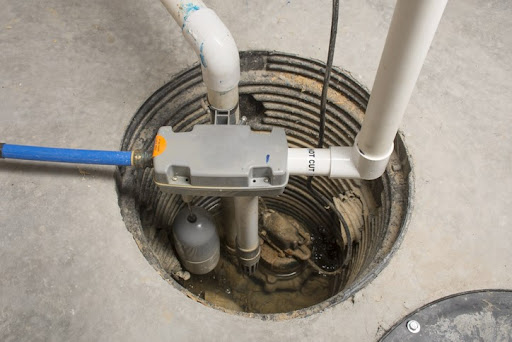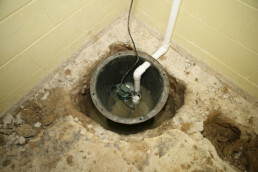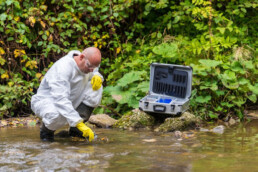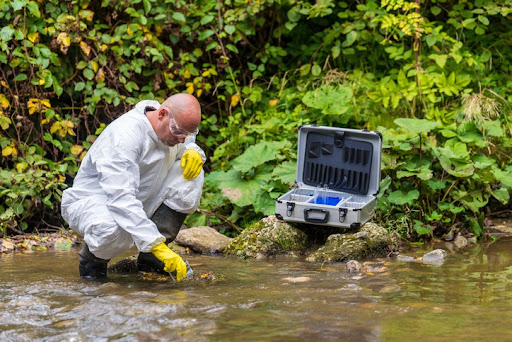Identifying and Solving Common Septic Tank Problems
As with any home system, issues with septic tanks can arise. Identifying and solving these problems promptly can save you time, money, and headaches. In this guide, you’ll learn more about septic tanks, the signs and causes of common septic tank problems, how to avoid them, and solutions for when issues occur.
How Septic Tanks Work
Septic tanks are underground storage systems that treat and dispose of wastewater for homes without traditional sewer connections. As a result, septic tanks are most commonly found in rural communities.
The tank separates solids from liquids, allowing the solids to settle at the bottom and the effluent to flow out into the drain field. Bacteria break down the solid waste into sludge, while the liquid waste filters through the soil in the drain field. This removes any remaining pathogens before percolating into the groundwater supply.
Signs of Septic Tank Problems
Detecting problems early is essential to prevent more significant issues from developing that could lead to expensive repairs or a complete system replacement. Watch out for the following signs that may indicate a problem with your septic tank:
- Slow drains: If sinks back up or toilets flush sluggishly, this could indicate a blocked or failing septic system.
- Foul odors: Unpleasant smells in the drain field may mean the tank is leaking or overflowing, both of which demand immediate attention to avoid a harmful or unsanitary situation.
- Soggy ground: If the area around the septic tank is wet and spongy, this could indicate a failing system or damaged drain field.
- Sewage backup: Wastewater backing up into your home is a clear sign of septic system problems.
- Lush, green grass: An unusually green and healthy-looking lawn around the septic tank may signify that the system is leaking and providing excess nutrients to the grass.
Common Causes of Septic Tank Problems
Septic tanks are designed to last at least 20 years, but many different factors can make them fail prematurely, including:
- Overloading the system: Excessive water use can overwhelm the tank and cause leaks or backups.
- Poor maintenance: Failing to pump the septic tank on the recommended schedule can cause it to overflow with solid waste, leading to blockages or a damaged drain field.
- Non-biodegradable items: Flushing items that can’t dissolve or be eaten by bacteria in the tank, such as facial tissue, wet wipes, and feminine hygiene products, may cause blockages.
- Invasive tree roots: Tree roots can infiltrate your septic system, blocking or damaging the pipes.
- Chemicals: Rinsing bleach or antibacterial agents down the drain kills the beneficial bacteria in your septic tank, disrupting the waste decomposition process.
How to Avoid Issues with Septic Tanks
Proper care and maintenance are the key to preventing the most common septic tank problems. Just follow these guidelines:
- Schedule regular maintenance: Hire a professional to inspect and pump your septic tank every three to five years.
- Conserve water: Be mindful of how much water you use and fix leaks promptly.
- Dispose of waste properly: Do not flush non-biodegradable items or use excessive cleaning chemicals.
- Protect the drain field: Avoid planting trees or driving heavy vehicles near where the septic tank is buried.
- Use bacterial additives: Septic tank additive help maintain the bacterial ecosystem necessary to break down solid waste effectively.
Solutions for Septic Tank Problems
If septic tank problems arise despite your best efforts, prompt action is necessary to prevent further damage. Consult a septic system professional for a thorough inspection and diagnosis. The technician may recommend the following solutions:
- Pump the septic tank: If you see signs that the tank is nearing capacity, stop your wastewater activities and call a professional immediately for septic pumping.
- Clear blockages: If your pipes or other septic system parts are clogged, a professional can clear them using a plumber’s snake or high-pressure water jet.
- Address damaged components: Repairs or replacement may be necessary if tree roots, heavy vehicles, or other factors have damaged the tank or drain field.
- Wait for bacterial additives to work: Your septic technician may apply biological additives to clear blockages naturally. It may take several days or even a few weeks for the bacteria to eat through the clogs, so limit your water usage during this time to allow the bacterial ecosystem to rebuild itself.
Address Septic Tank Problems in San Francisco
Dealing with septic tank problems can be challenging and stressful. If you’re in the San Francisco Bay Area, turn to Trinity Liquid Waste for help. Our years of experience, cutting-edge equipment, and commitment to customer service make us an excellent choice for residential and commercial septic system services. To request a septic inspection and diagnosis, please contact us today at 510-874-6489.
What is Septic System Biomat?
In rural and suburban areas where public sewer systems aren’t available, septic systems are essential for enjoying modern plumbing conveniences like toilets, showers, and dishwashers. A well-functioning septic system treats and disposes of wastewater in a sanitary and efficient manner, making it essential to the health and safety of humans and the surrounding environment.
One critical element of the septic system process is called the “biomat.” Most homeowners are unfamiliar with this term, but it significantly impacts your septic system’s efficiency and effectiveness.
What is Biomat in a Septic System?
Septic system biomat, also known as the biomaterial layer, is a naturally occurring, gelatinous substance that forms in the soil under and around the septic system drain field. It consists largely of anaerobic bacteria that don’t require a lot of oxygen to survive and is an essential component of the septic ecosystem. The primary function of the biomat is to filter and treat wastewater, preventing viruses, pathogens, and diseases from polluting the environment.
As wastewater flows through the septic system and enters the soil, it passes through the biomat layer, which serves as a biological filter. The living bacteria within the biomat break down and consume organic materials in the wastewater, converting them into simpler compounds that the soil can safely absorb. This process removes harmful contaminants and promotes gradual percolation to prevent over-saturating the soil.
How Long Does It Take for Biomaterials to Form?
The formation of the septic system biomat is a gradual process, occurring over time as the bacteria and organic matter accumulate. With every dishwasher cycle, shower, and toilet flush, you introduce new organic bacteria, which affect the septic ecosystem.
Plus, when the tank is pumped of all internal contents, the system takes about one to three weeks to regain the proper bacteria levels. The precise rate of biomaterial formation depends on the size and usage of the septic system, the soil type, and the presence of chemicals in the wastewater.
How to Maintain the Proper Biomat Levels
Homeowners can take several steps to ensure the biomat layer remains at an appropriate thickness. Here are some tips to try:
- Regularly inspect and pump the septic tank: Scheduling routine septic tank inspections and pumping every three to five years prevents the accumulation of sludge and other organic materials, reducing the strain on the biomat layer.
- Use water efficiently: Implementing water-saving practices reduces the volume of wastewater entering the septic system and decreases the burden on the biomat. Tactics include using water-efficient appliances and fixtures, repairing plumbing leaks, and spreading laundry/dishwasher loads throughout the week
- Avoid harsh chemicals: Bleach and other chemicals harm the beneficial bacteria within the septic ecosystem. Limit their use to maintain proper biomat levels.
- Landscape wisely: Planting trees and shrubs away from the septic system drain field prevents root intrusion, which can damage the biomat layer and the septic system itself.
- Use septic tank additives: The right additives applied at the proper time can boost the biological response within the septic system. However, using the wrong additives at the improper time can have detrimental effects. Work with a professional to help you choose the best septic tank additives and get the timing right.
What Happens if the Biomat Layer Becomes Too Thick?
As the septic system operates, the biomat layer naturally grows thicker. If it becomes excessively thick, the biomat can impede the drainage of effluent wastewater, leading to various issues. For example:
- A clogged biomat can cause wastewater to back up into your home or pool on the surface of the drain field, causing foul odors and unsanitary conditions.
- An overly thick biomat layer may allow effluent wastewater to rise and seep into the soil above the biomat, thus bypassing a critical filtration layer. This raises the risk of groundwater contamination if the wastewater is not filtered by other means.
In cases where the biomat layer becomes too thick, it may be necessary to perform septic system remediation. This process can involve repairing or replacing damaged components, adding supplemental biomaterial to restore the proper bacteria balance, or replacing the drain field. Work with a septic system professional to assess the situation and determine the best course of action.
Schedule Septic System Services in San Francisco
At Trinity Liquid Waste, we pride ourselves on offering comprehensive septic system services for residences and businesses in the San Francisco Bay Area. Our experienced technicians are committed to customer care and effective solutions for all your septic system needs. From routine inspections and pumping to complex system repairs and replacements, Trinity Liquid Waste is the reliable choice for keeping your septic system up and running. Contact us today at 510-874-6489 to schedule an appointment or learn more about our services.
What Causes a Septic System to Fail?
When a septic system fails, it can no longer effectively treat and dispose of wastewater, posing health and environmental risks. To better understand and prevent septic system failure, it’s essential to recognize the signs of a failing septic system and the common reasons behind it.
What Happens When a Septic System Fails?
Septic systems treat and dispose of wastewater generated by households not connected to a traditional sewer system. When functioning correctly, the system separates solid and liquid waste, breaking down the solids and allowing the liquid to filter through the soil. However, a failing septic system can’t perform these functions effectively, leading to issues like contaminated groundwater, unpleasant odors, and sewage backups.
What are the Signs of a Failing Septic System?
If you notice any of these telltale signs, your septic system could be failing and needs immediate attention:
- Slow-draining sinks and toilets: Among the first signs to look for are drains that empty slowly. This may indicate that the septic tank is full or a blockage has formed in the pipes leading to the tank.
- Sewage backups: Wastewater flowing up from your drains poses a serious health risk. This sign of septic system failure calls for emergency services from a septic system professional.
- Wet spots and foul odors in your yard: A failing septic system may cause water to pool in the drain field. This could mean the tank is overflowing or the drain field is malfunctioning. Foul odors typically accompany this problem because the wet spots contain raw sewage.
- Lush, green grass: While a lush lawn may seem like a benefit, if the grass over your drain field is significantly greener than the rest of your yard, it may signal a failing septic system. Excess untreated wastewater contains nutrients that fertilize your grass, but it’s unsafe to dispose of it this way.
- High nitrate and bacteria levels in well water: If you have a septic system, chances are your water comes from a private well. Regular testing is essential to protect your family’s health. Watch out for increased levels of nitrates and bacteria, which could indicate that untreated wastewater from a failing septic system is contaminating your well water.
What are Some Common Reasons a Septic System Doesn’t Work Properly?
Several factors can cause a septic system to fail, including:
- Improper installation: A septic system is set up for success or failure on installation day. Hire a qualified professional to install or replace your septic system to ensure reliable, long-term performance.
- Poor maintenance: Failing to pump your septic tank regularly can cause sludge and scum to accumulate, leading to blockages and system failure.
- Overloading the system: Sending excessive amounts of water into the septic system can overwhelm it and cause it to fail.
- Flushing non-biodegradable items: Septic systems are only prepared to handle human waste and septic-safe toilet paper. Flushing anything non-biodegradable, like paper towels, baby wipes, or feminine hygiene products, can clog the septic system.
- Using too many cleaning products: Chemicals and antibacterial soaps are problematic because they kill the bacteria in the tank responsible for breaking down waste. This can lead to the worst-case scenario of a completely clogged drain field.
- Tree root intrusion: Tree roots can infiltrate your septic system, causing pipe blockages and drain field damage.
- Soil compression in the drain field: A septic system can fail because of broken, crushed, or clogged pipes in the drain field. Heavy vehicle traffic is the most common cause.
How Can You Prevent Septic System Failure?
Now that you know what causes a septic system to fail, you can take steps to avoid them. Here’s how:
- Schedule routine maintenance: Septic tank pumping and inspections allow professionals to identify and address small issues before they become more severe.
- Limit water usage: Install water-efficient appliances and fixtures, repair plumbing leaks, and spread laundry/dishwasher loads throughout the week.
- Be mindful of what goes down the drain: Avoid flushing anything besides human waste and toilet paper, and minimize harsh chemicals that disrupt your septic tank’s bacterial balance.
- Protect the drain field: Avoid driving or parking vehicles on the drain field. Also, direct gutters and downspouts away from the drain field to prevent excess saturation.
- Monitor tree roots: Regularly inspect your septic system for tree root intrusion. Consider removing any trees with invasive roots that are too close to your septic tank.
Reliable Septic System Services in San Francisco
If you need septic services in the San Francisco Bay Area, turn to Trinity Liquid Waste. Our years of experience, prompt service, and commitment to customer satisfaction set us apart from other septic service providers. We perform preventative septic pumping and inspections, as well as septic repairs and 24-hour emergency service. Contact us today at 510-874-6489 to schedule routine maintenance or address any concerns with your septic system.
How Often Should You Pump Your Septic Tank?
A properly functioning septic tank is essential for safely treating and disposing wastewater. One of the most important ways to maintain your septic tank is to pump it regularly. Do you know how often to pump your septic tank? Learn the pumping schedule professionals recommend, warning signs that your tank is full, the importance of professional septic tank pumping services, and the advantages of prioritizing this maintenance task.
How Often Should a Septic Tank Be Pumped?
The recommended frequency of septic tank pumping depends on various factors, including the size of the tank, the number of people in the household, and the volume of wastewater generated. According to the Environmental Protection Agency (EPA), septic tanks should be pumped every three to five years, adjusting the specific pumping frequency based on your unique circumstances.
Consult a professional for help determining the appropriate pumping schedule for your tank. These experts can assess your tank’s capacity and usage, ensuring that your septic system remains in good working condition with less need for emergency pumping and repairs.
Can You Wait Longer to Pump Out Septic Tanks?
While it may be tempting to put off septic tank pumping to save money, waiting too long can lead to significant problems. Over time, solids accumulate in the septic tank, which can cause the system to work inefficiently and, ultimately, fail. This can result in costly repairs or even needing to replace the entire system. Simply following the recommended pumping schedule for your septic tank is enough to prevent these costly and inconvenient issues, making preventative maintenance a worthwhile investment.
Warning Signs of a Full Septic Tank
Keep an eye out for warning signs that your septic tank needs pumping so you can address issues before they become outright emergencies. Some common signs that your septic tank is nearing capacity include:
- Slow-draining sinks, bathtubs, and toilets: If your drains are slow to empty, it could indicate that your septic tank is full and backing up into the pipes. Pumping the tank should resolve the issue before it escalates any further.
- Unpleasant odors: Foul sewage smells wafting up from your drains and toilets clearly indicate that your tank is full and requires pumping. Heed unpleasant odors near the buried septic tank as well, which could warn you of sewage leaks in the drain field.
- Standing water or damp spots near the septic tank: Along with a smelly drain field, you may notice areas with standing water, even if it hasn’t rained recently. This could mean the tank is overflowing and wastewater is seeping into the surrounding soil.
- Sewage backup: If wastewater backs up into your home, you can bet your septic tank is full and needs immediate attention. The goal is to keep up with septic tank maintenance so this never happens.
Importance of Professional Septic Tank Pumping
When the time comes to pump your septic tank, hiring a professional is essential. Experienced technicians have the necessary equipment and training to ensure your septic tank is pumped correctly and safely. Along with this service, professionals can inspect your tank for potential issues, such as leaks or damage, and recommend appropriate maintenance to prevent costly repairs or system failures.
Advantages of Regular Pumping of Septic Tanks
Homeowners with septic tanks on their property benefit in several ways from routine pumping services:
- Prevent system failure: Regular pumping stops the excessive buildup of solids in your tank, reducing the risk of system backups and failure.
- Protect the environment: Properly maintained septic systems prevent groundwater contamination, preserving public health and protecting the environment. Professionals also dispose of waste material in an approved location to ensure eco-friendly services.
- Save money: Regular maintenance is a predictable, affordable cost that helps you avoid more expensive repairs and premature system replacements caused by septic tank failure.
- Extend the life of your septic system: On average, septic tanks last 20 to 40 years. Regular pumping and maintenance between professional inspections can significantly prolong your septic system’s lifespan. This ensures the tank and associated plumbing operate efficiently for years to come.
- Preserve property value: A well-maintained septic system is important in maintaining your property value and making your home more attractive to potential buyers if you decide to sell.
Schedule Septic Tank Pumping Services in San Francisco
Trinity Liquid Waste is a trusted provider of septic tank pumping services in the San Francisco Bay Area. With over 25 years of experience, our team is dedicated to providing exceptional service and expertise to meet all your septic system needs. Don’t wait until you see signs of a full septic tank—contact us today at 510-874-6489 to schedule septic tank pumping and maintain the health of your home’s plumbing system.
How Water Jetting Technology is Revolutionizing the Construction Industry?
Water jetting has been used in construction for many years, but its potential for accuracy and efficiency has only recently been fully realized. This technology uses a jet of water to cut through virtually any material quickly and precisely. Learn the advantages of using water jetting technology in construction, plus how a similar device can be used to clear clogged pipes.
Water Jetting Technology Provides Precise and Accurate Cutting
Waterjet cutting is more exact than traditional methods such as saws or drills. This means fewer mistakes are made during the construction process, resulting in a higher-quality finished product.
Water Jetting Technology Reduces Waste and Lowers the Environmental Impact
Compared to traditional sawing or milling, waterjet cutting generates very little waste. The material that is cut away is easy to collect and recycle. In addition, waterjet cutting generates very little dust or debris, reducing the pollutants released into the air to protect workers’ health and reduce the environmental impact of construction projects.
Water Jetting Technology Makes Construction Faster and Safer
Thanks to the precision and speed of waterjet cutting, construction projects can be completed in a fraction of the time. Workers no longer have to deal with handheld power tools and their slow, exhausting, and often inaccurate cuts. Water jetting technology is also much safer than traditional power tools, as there is no risk of sparks or flying debris. This is one of several reasons why waterjet cutting is preferred on many modern construction sites.
Water Jetting Technology has Various Cost-Effective Construction Applications
A waterjet is a multipurpose tool that can be used in both small and large-scale construction projects. Cutting and shaping stone, concrete, metal, and glass is certainly one use, but water jetting can also be used for engraving designs or carving patterns on surfaces such as tiles or countertops. It’s also an effective way to cut holes in walls for pipes and wiring penetrations and can be used for custom fabrication and other construction-related tasks. While water jetting technology requires an investment, it’s ultimately a versatile and cost-effective solution for numerous modern construction applications.
Other Uses for Water Jetting Technology
Water jetting may offer many benefits for those in the construction industry, but that’s certainly not the only place it’s used. A hydro-jet is a modified version of a waterjet cutter, capable of clearing even the most stubborn pipe blockages with a high-pressure stream of water around 35,000 pounds per square inch (psi). When a plunger or drain auger isn’t effective, the next step is to try water jetting!
At Trinity Liquid Waste, our water jetting services are designed to be a quick, cost-effective, and eco-friendly way to clear your stopped-up drains. Whether grease, hair, or tree roots have blocked your sewer line, we’re confident we can get things flowing again. Our team has over 25 years of experience, giving us the skills and knowledge to ensure a job well done. Call us today at 510-874-6489 or complete our online contact form to schedule same-day, 24/7 service in the San Francisco Bay Area.
The Difference between High-Pressure and Ultra-High-Pressure Water Jetting
High-pressure water jetting and ultra-high-pressure water jetting are two methods of cleaning and removing debris from pipes, surfaces, and equipment using pressurized water. However, they use different amounts of force, making them practical in different applications. Learn how ultra-high-pressure water jetting differs from traditional high-pressure water jetting to help you understand what’s best for your application.
High-Pressure vs. Ultra-High-Pressure Water Jetting
High-pressure water jetting involves water pressure of up to 20,000 pounds per square inch (psi) and is used for tasks such as clearing drains, removing buildup and tree roots from pipes, and cleaning surfaces. This method is effective when moderate pressure is required and the debris buildup is not excessively thick or tough. It’s typically the next thing to try if snaking a clogged drain doesn’t work.
Ultra-high-pressure water jetting uses water pressure of up to 40,000 psi or higher and is typically reserved for challenging tasks such as removing extremely tough coatings and buildup, breaking up concrete, and cutting through steel and other materials. This method is often necessary when standard high-pressure cleaning methods prove ineffective.
When to Use Ultra-High-Pressure Water Jetting
Ultra-high-pressure water jetting is most commonly needed in industrial settings, such as oil refineries, chemical plants, and power generation facilities, where equipment and machinery are subject to extreme wear and tear and the buildup of tough materials. It’s also ideal for lead remediation jobs and cleaning sensitive machinery where grit from abrasive blasting could be detrimental.
Benefits of High-Pressure and Ultra-High-Pressure Water Jetting
Whether you need to clear obstructed pipes or remove rust and scale from machinery, high-pressure or ultra-high-pressure water jetting could be the solution. The benefits of these pressurized water cleaning methods include the following:
- Effective at removing tough buildup: Traditional scraping or chemical cleaning methods can be time-consuming and ineffective. On the other hand, high-pressure or ultra-high-pressure water jetting can quickly and easily remove tough coatings and buildup, restoring equipment, machinery, and pipes to their optimal operating condition.
- Safe and environmentally friendly: Some cleaning methods involve harsh chemicals, solvents, or abrasives that can harm people, animals, and the environment. In comparison, water jetting relies solely on pressurized water power, making it safe and eco-friendly when cleaning tough materials.
- Quick to perform: High-pressure and ultra-high-pressure water jetting can be completed quickly, reducing downtime for your business.
- Able to break up concrete and other sturdy materials: Ultra-high-pressure water jetting is particularly useful for construction and demolition projects, where concrete must be removed quickly and efficiently. An ultra-high-pressure jet of water can even cut through steel, making it effective for cutting and shaping metal.
Are your drains slow or completely stopped up? Turn to Trinity Liquid Waste to get things flowing again. We provide same-day, 24/7 service to clear your drains quickly. Our experienced technicians are trained to use state-of-the-art water jetting equipment and have the knowledge and skills to handle even the most demanding cleaning tasks. Call us today at 510-874-6489 or complete our online contact form to schedule water jetting services in the San Francisco Bay Area.
How to Troubleshoot Common Sump Pump Problems
Sump pumps are vital for keeping your home safe and dry in rainy weather. While these devices are typically hardy and dependable, they experience problems occasionally. Here are some common sump pump problems and easy troubleshooting tips.
The Sump Pump Won’t Turn On
If the water is rising in the sump pit, but the pump won’t turn on, make sure it’s plugged in. Then, check the circuit breaker box, resetting any tripped breakers you find. If the pump still won’t turn on, the switch may be stuck, requiring you to call a professional to fix it. This is why regularly testing your sump pump is so important, so you have time to schedule a repair before the next storm hits.
The Sump Pump Runs Continuously
If your sump pump won’t turn off, the float could be positioned incorrectly. This component turns the pump on and off as the water level rises and falls. If the float is positioned too high, the pump may continue running when the sump pit is dry. This can cause unnecessary wear and tear and cause the motor to burn out prematurely. Check and adjust the float’s position if necessary. If that doesn’t work, call a professional to check for a stuck switch, which may be causing the pump to run continuously.
The Sump Pump Makes Strange Noises
This could be due to a damaged impeller, loose bearing, or clogged pump. Turn off and unplug the sump pump before checking for debris in the impeller or housing. If the impeller is damaged or the bearing is loose, call a professional to replace it.
The Sump Pump Vibrates Excessively
Excessive vibration is a sign that the pump is not installed correctly. Make sure the pump is sitting level in the pit and not touching the walls. If poor installation isn’t to blame, the issue may be with the impeller or bearings. In this case, call a professional to diagnose and fix the problem.
The Sump Pump Won’t Pump Water
A clogged or frozen discharge pipe could prevent the sump pump from working even though the motor is running. Check the pipe for debris or ice buildup and clear anything you find. If the pipe is clear, but the pump still isn’t pumping, the impeller or motor could have a problem. You’ll need a professional to diagnose and fix these underlying issues.
The Sump Pump Short Cycles
Short cycling is when the sump pump turns on and off too frequently. A faulty float switch or undersized pump could be to blame. Check the float switch position and adjust it if necessary. If that doesn’t work, you may need to upgrade to a larger pump.
If you’re experiencing problems with your sump pump, turn to Trinity Liquid Waste for help. We offer a range of sump pump services, including installation, repair, and maintenance. Our team boasts over 25 years of experience keeping homes and businesses in the San Francisco Bay Area safe and dry. For more information about troubleshooting your sump pump or to schedule a repair, please contact us at 510-874-6489 today.
How to Choose the Right Sump Pump?
Are you prepared for the rainy season? If you don’t already have a sump pump in your San Francisco Bay Area home, consider installing one to prevent rising groundwater from entering and damaging your home. Many types of sump pumps are available today, so it can be challenging to make a confident selection. Use this guide to help you choose the right sump pump features for your home.
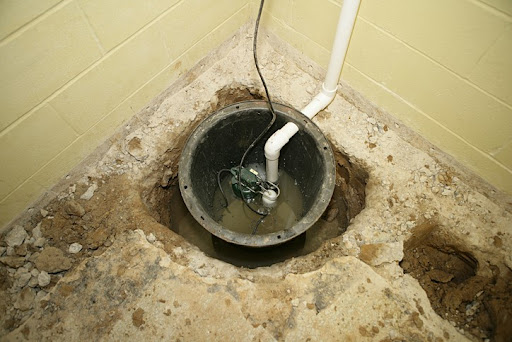
- Consider your needs: How large is the lowest level of your home? How often does flooding occur in your area? How much water do you need to pump out? A professional can help you answer these questions to help you begin the process of choosing the right sump pump.
- Compare the two main types of sump pumps: Sump pumps come in two primary forms—submersible and pedestal. Submersible pumps are placed in the sump pit and are designed to operate while underwater. Pedestal pumps are mounted above the sump pit and work while out of the water. Submersible pumps are generally more expensive than pedestal pumps but offer greater durability, efficiency, and quiet operation.
- Look at the horsepower: A sump pump’s horsepower determines how much water it can remove. A 1/3 HP sump pump provides average water removal, while 1/2 and 3/4 HP models address above-average needs. Work with a professional to help you choose a powerful enough pump to meet your needs.
- Install a backup system: Power outages are common during heavy storms, which is when you need your sump pump the most. A setup with a secondary pump or battery backup system ensures your home stays dry even if the power goes out. Everyone should consider some form of sump pump backup, especially if the home’s lowest level is used as a living space or storage area for valuables and keepsakes.
- Consider the noise level: The operating sound of a sump pump can be annoying if it’s located in a living area. If noise is a concern, choose a pump with a low decibel rating. Also, remember that submersible pumps allow the sump pit to be covered with a lid, reducing the noise level even further.
- Hire a professional to install your sump pump: Sump pump installation is not a DIY project. Knowledge and experience are required to install the pump correctly, make sure it works effectively, and help it last as long as possible. Once you’ve invested in a pump and had it professionally installed, remember to test the check valve regularly to ensure it functions properly when you need it most.
If you own a home or business in the San Francisco Bay Area, turn to Trinity Liquid Waste for the sump pump services you need. We offer sump pump installation, repair, and maintenance to help keep your property safe and dry. Our team boasts over 25 years of industry experience, and we are dedicated to providing the best customer service possible. For more information about choosing a sump pump or to schedule an appointment, please contact us at 510-874-6489 today.
Septic Maintenance Tips to Prolong Your System’s Lifespan
Septic systems are essential for homes not connected to a public sewer system. They treat and dispose of household wastewater in an underground tank and drain field. Using and maintaining your septic system properly ensures longevity and effectiveness. Learn the top seven tips for maintaining your septic system to keep it working well for many years.
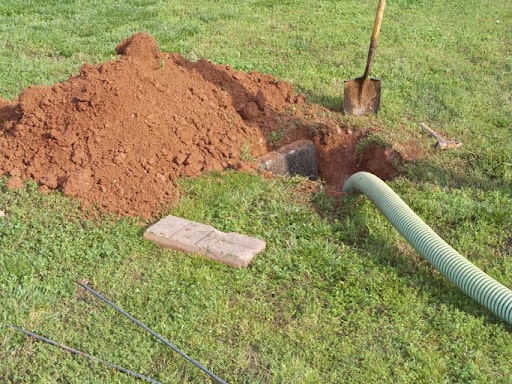
- Mind what you flush: Septic systems are designed to treat and dispose of human waste and biodegradable materials, so avoid flushing anything besides number one, number two, and toilet paper. This includes “flushable” wipes, feminine hygiene products, paper towels, and facial tissues.
- Think at the sink: Even with a garbage disposal, cooking grease, coffee grounds, and fatty food scraps should never go down the kitchen sink if you have a septic system. Dairy products are also harmful to pour down the drain because the lack of oxygen in the septic tank impairs the breakdown process.
- Use cleaning chemicals sparingly: Cleaning products can harm the good bacteria in a septic system. Therefore, it’s important to avoid antibacterial soap and disinfectants containing ammonia. Check your laundry detergent and toilet bowl cleaner as well to ensure they don’t contain bleach. Finally, never use a chemical drain cleaner with a septic system.
- Conserve water: Unlike public sewer systems, septic tanks can only handle so much wastewater at a time. Conserving water reduces the strain on the system and prevents overflows. Fix leaky faucets promptly, use low-flow fixtures, and avoid running multiple water sources simultaneously. Additionally, spread out water usage throughout the week instead of doing all the laundry or dishes on the same day.
- Protect the drain field: The drain field is where treated wastewater disperses into the soil. Keep this part of your yard clear of trees, bushes, and concrete structures. Then, don’t park or drive over the drain field, as this can compact the soil and harm the septic system.
- Schedule regular inspections: Professional septic inspections help spot small issues before they become major problems. Schedule an inspection every one to three years, before buying or selling property, and anytime you notice signs of septic trouble.
- Pump the septic tank regularly: A septic tank holds all the solid waste that enters the system. Over time, the tank fills up and must be pumped. Failing to do so can lead to solids entering the drain field or wastewater backing up into your home. That’s why it’s so important to keep up with this service every three to five years or as needed based on your tank’s size and the amount of use it receives.
Trinity Liquid Waste is a trusted provider of septic tank pumping, septic inspections, and septic repairs for residential and commercial customers in the San Francisco Bay Area. Our team of professionals aims to keep your system in top condition, drawing on over 25 years of industry experience. The next time you need septic services, don’t hesitate to reach out! You can call us at 510-874-6489 or fill out our online contact form.
What’s the Difference between a Septic Inspection and a Septic Pump-Out?
Maintaining a septic system is crucial to avoid costly repairs and ensure a long, reliable lifespan from your wastewater treatment system. The two main preventative septic services include septic inspections and septic pump-outs. Learn the difference between the two and how to tell when you need each one.
Septic Inspections
A septic inspection involves evaluating a septic system to determine its condition. Inspections should be conducted by a licensed professional with the expertise and equipment necessary to assess the septic tank, pipes, drain field, pumps, and other mechanical parts.
The primary purpose of a septic inspection is to identify any issues before they become serious problems. The inspector looks for signs of damage or wear and tear, such as cracks or leaks in the tank or pipes. They also check the drain field to ensure it’s absorbing wastewater properly and not becoming clogged with solids or other debris.
During a septic inspection, the technician begins by reviewing the system’s repair and maintenance history. They may also ask about your water usage habits and any changes since your last inspection, such as increased household occupants.
After this initial phase, the inspector conducts a visual examination. They may also use specialized equipment, such as a fiber-optic camera, to inspect components in hard-to-reach areas.
Once complete, the technician leaves you with a report detailing their findings and any recommended repairs or maintenance. Heed the information in this report to keep your septic system functioning properly and prevent costly repairs down the road.
A septic inspection is typically recommended every three years to determine if it’s time for septic pumping or if you can wait another year or two for this service. You should also schedule an inspection if you’re buying or selling a house with a septic system, or if you start noticing plumbing problems, such as slow drains, gurgling sounds, or foul odors.
Septic Pump-Outs
A septic pump-out involves removing the solid waste and sludge that accumulates in the septic tank over time. This service maintains the proper functioning of your septic system, as a full tank can lead to backups and other issues.
During a septic pump-out, the technician uses a hose to pump waste from the tank into a vacuum truck. Then, they hose down the tank to remove any remaining debris or build-up. Finally, the team disposes of waste material in an approved location, such as a wastewater treatment plant.
The Environmental Protection Agency (EPA) recommends pumping your septic tank every three to five years, depending on the size of the tank and the amount of use it receives. More frequent pump-outs may be needed if the system sees heavy use. Scheduling an inspection first helps you know when it’s time to pump the tank.
Trinity Liquid Waste offers professional septic inspections and pump-outs to keep your wastewater treatment system flowing smoothly. Our team of licensed professionals has over 25 years of experience serving residential and commercial customers in the San Francisco Bay Area. Rest assured that we have the necessary tools and expertise to assess your system, keep it functioning reliably, and extend its lifespan. Don’t wait for a septic system emergency—call us at 510-874-6489 or contact us online to request a septic inspection or pump-out today.

